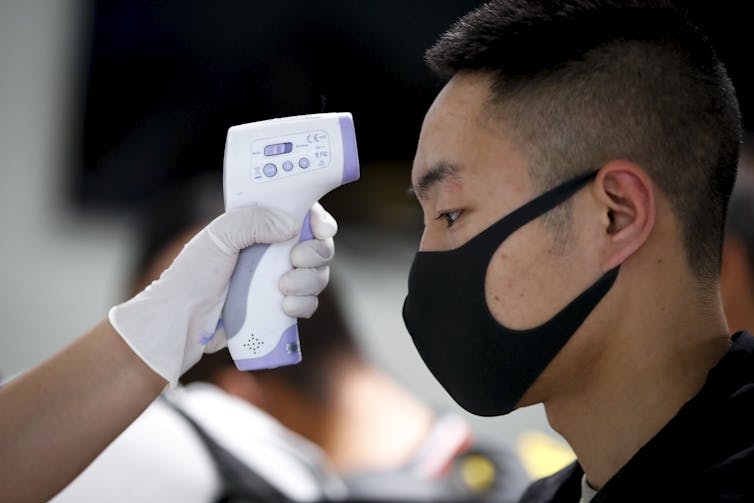In this cross-posting with The Conversation, epidemiologist Tim Spector from the King’s College London ponders the pros and cons of swapping inconclusive temperature testing for ‘sniff tests’ at public hotspots such as airports.
One of the best ways of containing the spread of COVID-19 is to rapidly identify people infected with the coronavirus and prevent them from passing it to others.
Temperature checks are now being used as a public screening tool for identifying people with COVID-19, with countries such as Taiwan using temperature checks as a key component of their containment measures. Yet there is little scientific evidence that temperature checks enable reliable detection of COVID-19.

For a start, handheld scanners only measure skin temperature, which can be variable, rather than core temperature – and there are issues with unreliable equipment. Data from the ZOE COVID Symptom Study app suggests that over half of people (57 per cent) who test positive for COVID-19 never develop a fever, while those who do have a raised temperature only have it for an average of two days. It’s unsurprising that temperature screening at airports would fail to detect most infected people.
If using temperature checks to detect COVID may provide little more than a false sense of security, what should we do instead?
Using ‘sniff tests’ to identify COVID cases
Data from 4 million users of our app has helped us to confirm that loss of smell (anosmia) was a key symptom of COVID-19 in April. We contributed to getting the UK and other countries to adopt it as an official symptom. Writing in The Lancet with the latest app data, my colleagues and I highlight that 65 per cent of adults who tested positive for COVID-19 reported a loss of sense of smell, with a significant proportion of them never experiencing a raised temperature, while just over 40 per cent of people testing positive had a fever.
For around 16 per cent of people who tested positive, loss of sense of smell was the only symptom they had. Importantly, during COVID-19 infection, anosmia lasts about seven days and often longer, while fever only lasts for three days for most people.
Also, a study by scientists at UCL has shown that over 75 per cent of people who reported losing their sense of smell during the first wave of the virus tested positive for coronavirus antibodies, despite one in four of them showing no other classic symptoms.
Overall, the data suggests that a sudden loss of sense of smell is a more common early symptom of COVID-19 than fever across all age groups. It is a 20-fold better predictor of a positive test for COVID-19 in younger people and a 13-fold better indicator in older people than any other symptoms.
Based on these findings, using “sniff tests” rather than temperature checks might be a better way of widespread screening in places like airports and hospitality venues. While it seems like a great idea in theory, unfortunately, there’s a catch.
Why ‘sniff tests’ are a bad idea
First, a diminished sense of smell is quite common. Nearly 20 per cent of adults have some degree of smell loss – a figure that rises to 80 per cent for the over-75s. It’s unlikely that any of these people would have any proof of their pre-existing smell loss that could exempt them from any sniff test restrictions.
Second, when we looked at the data from our app, we found that most people took around one week to regain their sense of smell after having COVID-19. But around one in ten people lose their sense of smell for three weeks or more – much longer than they are likely to be infectious.
Finally, many of us lose our sense of smell when we are suffering from a blocked nose caused by a regular cold, sinusitis or hay fever. Although a stuffy nose isn’t considered to be a symptom of COVID-19, a simple sniff test may not be able to discriminate between the two.
This means that although sniff tests may identify people with COVID-19 at the time of infection, there would also be a substantial number of non-infectious people who would also fail the test and face unnecessary restrictions.
So while a “sniff test” is probably not the answer, a sudden change in your sense of smell is still probably the best indicator of an early COVID-19 infection. Our app showed the symptom is less common in children, but this may be because they are less likely to notice unless tested.
Checking for changes in your sense of smell is easy and can be done daily from home with simple scented household items such as coffee, lemons, herbs or smelly cheese. If you discover any sudden changes to your or your children’s sense of smell that aren’t normal for you, you should self-isolate and get tested for COVID-19 as soon as possible.











